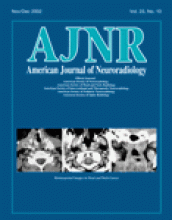Abstract
BACKGROUND AND PURPOSE: Time-of-flight (TOF) magnetic resonance angiography (MRA) is commonly used to visualize the carotid arteries; however, flow void artifacts can appear. Our purpose was to determine the frequency and diagnostic meaning of flow voids by using real patient data, as part of a larger study of MRA compared with the criterion standard, digital subtraction angiography (DSA).
METHODS: In 1997–2000, 390 consecutive patients with sonographic findings suggestive of carotid artery stenosis were included in this study. All patients subsequently underwent three-dimensional (3D) TOF MRA and conventional DSA. The frequency of flow void artifacts on 3D TOF MRA images were compared with stenosis measurements on DSA images.
RESULTS: We recorded 107 flow voids (16%) during 3D TOF MRA of 662 carotid arteries. DSA images were available for comparison in 102 cases. The median percentage of stenosis in this subgroup of flow voids on MRA images was 80%, compared with measurements on DSA images according to the North American Symptomatic Carotid Endarterectomy Trial (NASCET) criteria. Stenoses ranged from 36% to 100% (occlusion). Three flow voids (2.9%) were in the 0–49% range; 11 (10.8%), in the 50–69% range; and 86 (84.3%), in the 70–99% range. Two flow voids (2.0%) represented occlusions. The positive predictive value of a flow void artifact for the presence of severe (70–99%) stenosis was 84.3% (95% CI: 77.3%, 91.4%).
CONCLUSION: Flow void artifacts represented severe stenosis in most of the arteries. According to our data, the assumption that flow voids on 3D TOF MRA images represent severe stenosis is justified.
- Copyright © American Society of Neuroradiology












